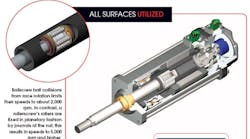A bed of nails doesn’t injure because pressure — force per unit area — decreases with each added nail. In the same way, rollerscrews divide load over more area for increased stiffness, shock resistance, and static load capabilities — even up to 779,000 lbf. The rollers surround their threaded shaft in a planetary arrangement to convert rotary motor motion into linear shaft or nut advancement. The design uses multi-thread helical rollers cut to the same thread angle as their nut, so all roller surfaces can be utilized for the most load bearing in the smallest possible space.
With higher load capacities comes longer working life. Usually measured in inches of travel, with a 2,000-lbf load applied to a 1.2-in. screw diameter with a 0.2-in. lead, a rollerscrew’s expected service life is 15 times greater. Scroll down for some common rollerscrew-stiffness questions and answers.
Question: How is rollerscrew stiffness increased?
A: Stiffness affects the precision of components, so unrestrained components cause excessive impact, noise, and wear. Stiffness — the ratio of the force applied to a component to the amount it deflects — is higher in rollerscrews. More contact of parts within the nut makes for stiffer torsional transmission, while any loads travelling on the device are spread over more supportive area. Reducing sections of “overhang” with larger total contact area is what results in less deflection and higher stiffness: It’s analogous to a larger-diameter rod possessing more rigidity than a small rod. Within the rollerscrew design, stiffness varies directly with area and the elasticity modulus, and inversely with length.
Q: Which rollerscrew designs are appropriate for which applications?
A: Planetary rollerscrews are suitable in precise applications requiring linear motion, often replacing hydraulics because of their load and cycle capabilities. The non-recirculating rollers come in three different styles. Single, non-preloaded nut rollerscrews have minimal backlash of 0.01 to 0.03 mm, and are ideal for most applications. Designed to eliminate backlash entirely, split nuts are preloaded by clamping the two halves of the nut together, spaced by a precision ground washer. (Usually preload is about 5% of dynamic load rating.) Double nuts combat problems on several fronts: Load ratings and life reach those of single nuts with zero backlash. A double nut consists of two single nuts preloaded against each other, clamped, and spaced by a precision-ground washer.
Q: What about when space is an issue?
A: Special inverted rollerscrew designs can be built within a servomotor’s armature. As the design’s long internally threaded armature rotates, its roller components travel inside it. Compared to traditional rollerscrews, which include a threaded shaft and riding nut, the inverted rollerscrew cuts length in half because the roller screw mechanism is completely contained within the armature of the motor — providing the most compact package. Compared to traditional actuators, the inverted rollerscrew design cuts width in half if the motor and actuator are mounted in parallel.
Tips provided by John Walker of Exlar Corp., Minneapolis. For more information, call (952) 368-3434.
